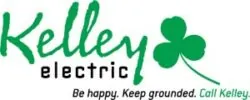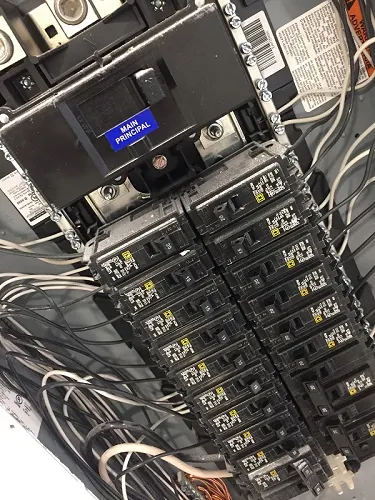If you live in an older home in the Lehigh Valley, there’s a good chance you still have two-prong outlets installed in some areas of your house. These outdated electrical receptacles are a common sight in homes built before the 1960s and can pose more than just a minor inconvenience. They may look harmless, but two-prong outlets lack the grounding needed for modern safety and performance standards. In today’s home environment, where electronics and appliances rely on proper grounding for protection, replacing your two-prong outlets may not only be a good idea, it might be essential.
In this comprehensive guide, we’ll explore what two-prong outlets are, why they’re no longer considered safe, how grounding works, and when it’s time to upgrade. We’ll also explain the differences between GFCI and AFCI protection, how these modern safety technologies work, and where current electrical code requires them. If you’ve been wondering whether it’s time to update your old outlets, this guide will help you make an informed decision.
What Are Two-Prong Outlets?
Two-prong outlets, also called ungrounded outlets, have two slots and no grounding hole. One slot is hot and the other is neutral. This type of outlet was standard in American homes until the late 1960s, when three-prong grounded outlets became the new norm due to updated National Electrical Code (NEC) requirements.
A grounded outlet has a third round hole, which connects to a ground wire. This grounding provides a safe path for stray electrical current to travel in the event of a fault. Without that grounding, the current has nowhere to go, which increases the risk of electrical shock, damage to appliances, and even fires.
Why Are Two-Prong Outlets a Problem?
Even if your old outlets seem to work fine, they come with several risks:
-
No grounding means higher shock hazard. Any metal part of an appliance plugged into an ungrounded outlet can become electrified if there is a fault, putting you at risk of electrocution.
-
Higher risk of electrical fires. Ungrounded outlets can overheat or arc under fault conditions, increasing the potential for a house fire.
-
Sensitive electronics are unprotected. Modern computers, TVs, and appliances are designed to operate safely on grounded circuits. Using a two-prong outlet can increase the risk of internal component damage.
-
Home insurance issues. Some insurance companies consider two-prong outlets a liability and may require updates before offering or renewing a policy.
-
Resale complications. During home inspections, ungrounded outlets can raise red flags for buyers and slow down or complicate the sale of your home.
Can You Use Three-Prong Adapters with Two-Prong Outlets?
You may have seen or used a “cheater plug” adapter that allows a three-prong plug to fit into a two-prong outlet. While this might seem like an easy workaround, it is not a safe or compliant solution. These adapters often rely on the assumption that the faceplate screw is grounded, which is not always the case, especially in older homes.
Using a three-to-two adapter does not provide real grounding, and doing so can result in unsafe conditions. This is especially true for appliances and electronics that draw significant power or have metal exteriors.
How to Know If Your Outlets Are Grounded
Not all two-slot outlets are necessarily ungrounded. The only way to know for sure is to test the outlet using a receptacle tester or consult a licensed electrician. A professional can determine whether your electrical wiring includes a ground wire and whether it’s properly connected.
Some older homes may have metal conduit that can provide a ground path, but the reliability and continuity of that path needs to be tested.
What Are Your Options for Replacing Two-Prong Outlets?
If your home still has ungrounded outlets, here are the typical upgrade options:
1. Install a Grounded Three-Prong Outlet
This is the ideal solution and provides full protection. However, it requires that a ground wire already exists in the outlet box. If your home wiring lacks a ground wire, then rewiring may be necessary.
2. Install a GFCI Outlet Without Ground
The National Electrical Code allows the installation of a GFCI outlet in place of a two-prong outlet, even without a ground, provided it is labeled “No Equipment Ground.” A GFCI outlet protects against electrical shock by monitoring the balance of current and disconnecting the circuit when a fault is detected. This doesn’t provide grounding but offers increased safety.
3. Rewire the Circuit
If your home has numerous ungrounded outlets, it may be worth rewiring the circuits to include a ground wire. This is especially important in areas where grounded outlets are now required by code, such as kitchens, bathrooms, and garages.
4. Install GFCI Breakers in the Panel
In some cases, a GFCI breaker can be installed in the main panel to protect the entire circuit, even if individual outlets remain ungrounded. However, each outlet still needs to be labeled as ungrounded, and this doesn’t provide surge protection for sensitive electronics.
What Is a GFCI Outlet and Why Is It Important?
GFCI stands for Ground Fault Circuit Interrupter. These outlets monitor the flow of electricity and shut off power in milliseconds if an imbalance is detected. This is crucial in areas where water is present, such as:
-
Bathrooms
-
Kitchens (especially near sinks)
-
Laundry rooms
-
Garages
-
Basements
-
Outdoor receptacles
GFCI protection helps prevent shock-related injuries and is a critical part of modern electrical safety. In the Lehigh Valley, where older homes are common, adding GFCI protection is one of the most effective upgrades you can make.
Where GFCIs Are Required by Code
According to the 2023 NEC (which Pennsylvania generally follows closely), GFCI protection is required for all 15- and 20-amp, 125-volt receptacles located in the following areas:
-
Bathrooms
-
Garages
-
Outdoors
-
Crawl spaces
-
Unfinished basements
-
Kitchens (within six feet of the sink)
-
Laundry areas
-
Utility rooms
-
Wet bar sinks
Even if you don’t rewire the home, upgrading to GFCI outlets in these locations is a cost-effective way to increase safety and meet minimum code requirements.
What Is an AFCI Outlet and When Is It Needed?
AFCI stands for Arc Fault Circuit Interrupter. Unlike GFCIs, which protect against shock hazards, AFCIs protect against electrical fires caused by arcing faults. These are high-energy discharges that can happen when wires become loose or damaged.
AFCI protection is typically provided at the breaker panel, though there are also outlet-style devices available. It is now required by code in the following areas:
-
Living rooms
-
Bedrooms
-
Dining rooms
-
Sunrooms
-
Hallways
-
Closets
Many newer homes come with AFCI protection standard. However, older homes in the Lehigh Valley likely do not have this safeguard. If you’re planning any kind of remodeling, it’s a good time to consider installing AFCI breakers or devices.
When Does Code Require You to Upgrade?
If you’re not doing any electrical work, you are generally not required to upgrade existing two-prong outlets. However, as soon as you:
-
Replace an outlet
-
Add a new receptacle
-
Renovate or remodel an area
-
Replace or upgrade your electrical panel
Then you are obligated to bring that part of your electrical system up to code. This means adding GFCI or AFCI protection where required, using properly grounded receptacles, and ensuring all installations comply with NEC standards and local building codes.
Safety vs. Convenience
Upgrading your electrical system is not just about convenience or aesthetics. It’s about protecting your home, your electronics, and your loved ones. Even if you aren’t planning a full rewire, strategic upgrades can dramatically improve safety and help avoid costly repairs or insurance issues down the road.
GFCI and AFCI protection are both vital in preventing the most common types of residential electrical hazards. They’re affordable, accessible upgrades that Kelley Electric can install quickly and professionally.
How Kelley Electric Can Help
As a trusted residential electrician serving the Lehigh Valley, Kelley Electric specializes in helping homeowners modernize their wiring and stay code compliant. Whether you need a few outlets upgraded or you’re planning a whole-home renovation, our licensed electricians can walk you through your options and perform the work safely and efficiently.
We don’t just swap out outlets. We evaluate your home’s overall wiring condition, test for grounding, and help you prioritize where safety upgrades are most needed. We understand the unique challenges of older homes in this region and tailor every project to fit your home’s architecture, age, and budget.
Key Takeaways
-
Two-prong outlets are outdated, ungrounded, and pose significant safety risks in modern homes
-
Replacing two-prong outlets with grounded three-prong outlets or GFCI outlets improves safety and helps meet current electrical codes
-
GFCI protection helps prevent shock in wet areas. AFCI protection helps prevent fires in living spaces
-
Upgrades are required by code when replacing outlets, remodeling, or upgrading your panel
-
Replacing old outlets with GFCIs labeled “No Equipment Ground” is a safe and code-compliant option if grounding isn’t available
-
Kelley Electric offers expert outlet replacement, safety inspections, rewiring services, and code compliance support across the Lehigh Valley
Ready to Update Your Outlets?
If you’re still living with outdated two-prong outlets, don’t wait for a hazard to strike. Upgrading your outlets is a smart step toward making your home safer and more functional. Contact Kelley Electric to schedule an inspection or outlet upgrade. Our licensed electricians are ready to help you bring your home’s electrical system into the modern age, safely, affordably, and code-compliantly.


